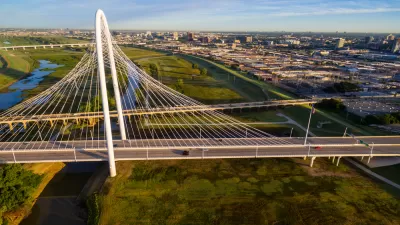A whitewater feature built into the Trinity River in Dallas will have to go—it rendered the river unnavigable and thus breached the terms granted by a U.S. Army Corps of Engineers permit.
"The Dallas City Council voted Wednesday to spend almost $2 million to partially remove the whitewater feature in the Trinity River that opened and closed in a matter of days in the spring of 2011 after the Army Corps of Engineers said it rendered the river unnavigable," reports Robert Wilonsky.
The decision effectively ends the saga that began from day one of the "Standing Wave's" existence.
The city has spent years grappling with the $4 million whitewater feature beneath the Santa Fe Trestle. The issue was never with the feature itself, which kayakers continued to use even after the city officially closed it, but the narrow bypass channels. They were supposed to offer boaters a calm alternative to the human-made rapids. But, instead, they were far more turbulent than the Wave itself.
As far as the corps was always concerned, the bypass channels rendered the river unnavigable. And that violated the permit that allowed the city to construct the Dallas Wave.
Last Planetizen checked-in with the project, the city was reacting to a failed legal effort to force the U.S. Army Corps of Engineers to change its designation of the river. Now the city has been forced into choosing the cheapest of three options: $7.4 million to completely remove the feature, $4.2 million to modify it, and $2 million to partially remove it.
FULL STORY: Dallas will spend $2 million to remove $4 million whitewater feature from Trinity River

Study: Maui’s Plan to Convert Vacation Rentals to Long-Term Housing Could Cause Nearly $1 Billion Economic Loss
The plan would reduce visitor accommodation by 25,% resulting in 1,900 jobs lost.

North Texas Transit Leaders Tout Benefits of TOD for Growing Region
At a summit focused on transit-oriented development, policymakers discussed how North Texas’ expanded light rail system can serve as a tool for economic growth.

Using Old Oil and Gas Wells for Green Energy Storage
Penn State researchers have found that repurposing abandoned oil and gas wells for geothermal-assisted compressed-air energy storage can boost efficiency, reduce environmental risks, and support clean energy and job transitions.

Santa Barbara Could Build Housing on County Land
County supervisors moved forward a proposal to build workforce housing on two county-owned parcels.

San Mateo Formally Opposes Freeway Project
The city council will send a letter to Caltrans urging the agency to reconsider a plan to expand the 101 through the city of San Mateo.

A Bronx Community Fights to Have its Voice Heard
After organizing and giving input for decades, the community around the Kingsbridge Armory might actually see it redeveloped — and they want to continue to have a say in how it goes.
Urban Design for Planners 1: Software Tools
This six-course series explores essential urban design concepts using open source software and equips planners with the tools they need to participate fully in the urban design process.
Planning for Universal Design
Learn the tools for implementing Universal Design in planning regulations.
Ascent Environmental
Borough of Carlisle
Institute for Housing and Urban Development Studies (IHS)
City of Grandview
Harvard GSD Executive Education
Toledo-Lucas County Plan Commissions
Salt Lake City
NYU Wagner Graduate School of Public Service




























